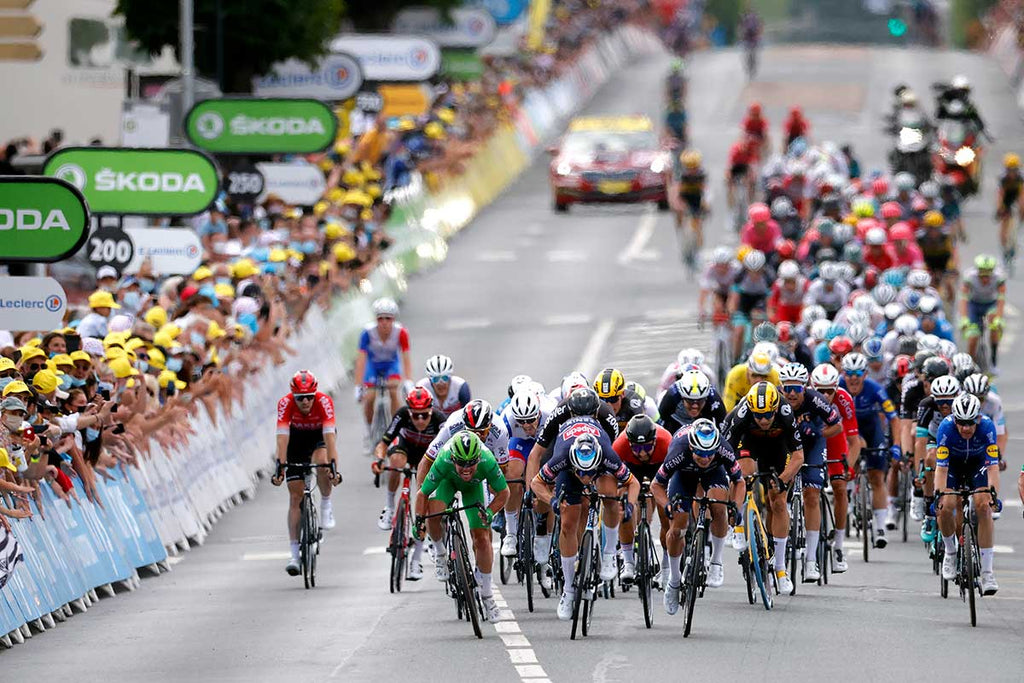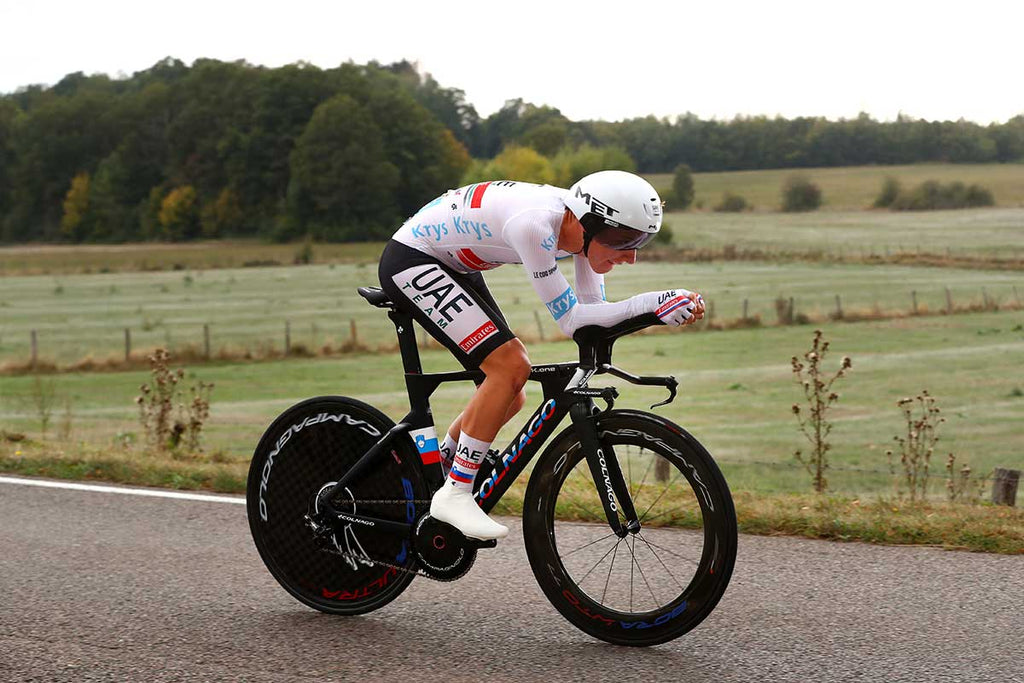To cycle 3,328 km in 21 days (with only two days of rest), you need to be incredibly fit. What's more, you need to be even fitter to cycle that length at an average speed of 40kph. And to survive the 48,859 metres of vertical elevation spread along the course, you must be in the best shape of your life.
That's equal to cycling from New York to Albuquerque, New Mexico, or Manchester, UK to Athens, Greece, and climbing Mount Everest 5.5 times in between. In 21 days, with only two rest days. That, in simple maths, is what it takes to finish the 2022 Tour de France. Simple, right?
That, in simple maths, is what it takes to finish the 2022 Tour de France. Simple, right?
But how fit do professional riders need to be if they want to ride the Grande Boucle and finish it, let alone win it?
Have they done it before?
"The first, most obvious step is knowing if a rider can race a three-week stage race because that's quite a unique physical demand, and they need to get through that in a good way," explains Dajo Sanders, sport scientist and coach for the DSM pro cycling team.
Related: How fast is the Tour de France?
If a rider has already completed a Grand Tour or a shorter stage race, that is a suitable starting parameter. But what about other riders who have not completed one yet? And what is the demand, in general?
Aerobic powerhouse
"They need to tolerate the high load of racing that is a Grand Tour, with repeated hard days of racing. And they all need to have a strongly developed aerobic system [ability to burn fat and carbs in the presence of oxygen] to tolerate such a high load. That takes some time to develop," Sanders says. The ability to use fats and carbs efficiently at an intensity level where the body uses oxygen too (differently from the anaerobic system or higher intensity efforts) is paramount in endurance sports – and even more so in longer events or multi-day races. The riders who perform best while producing energy aerobically and saving energy at the same time are the ones who are usually more successful in endurance races like the Tour de France.
The ability to use fats and carbs efficiently at an intensity level where the body uses oxygen too (differently from the anaerobic system or higher intensity efforts) is paramount in endurance sports – and even more so in longer events or multi-day races. The riders who perform best while producing energy aerobically and saving energy at the same time are the ones who are usually more successful in endurance races like the Tour de France.
But then, within the peloton, we know there are different types of riders: GC contenders, breakaway specialists, time triallists, and sprinters. Do they all need to match the same requirements? Yes and no.
Related: One kilo a day. What riders eat on hard, Alpine stages at the Giro
"We look at a multitude of metrics, but how we interpret those numbers depends a lot on what their main role is," explains Sanders.
And, also very importantly, all types of riders need to produce their best power outputs in a race scenario because it's pretty different to do it when they're fresh and when there's the onset of fatigue. As Sanders and other researchers showed last year with this study, what separates the best riders from the rest of the peloton is the ability to maintain a high power output after accumulating high workloads.
Different physiology, different metrics
"The attributes of a sprinter are going to be different than those of a rider contesting the general classification," he points out. "If you take a sprinter, their success depends on their ability to produce high bursts of power for 10 to 15 seconds at the end of the stage." And that means sprinters not only need to have a good aerobic system to survive the long stages (day in and day out), they also need to have world-class anaerobic and creatine-phosphate systems, where they produce the highest power output without oxygen and in a short amount of time.
And that means sprinters not only need to have a good aerobic system to survive the long stages (day in and day out), they also need to have world-class anaerobic and creatine-phosphate systems, where they produce the highest power output without oxygen and in a short amount of time.
In training, if a rider has not completed a Grand Tour, or if they have and are still fighting for the spot in the team, Sanders and his colleagues look at several metrics. For example, for sprinters, they look at their ability to perform well aerobically for several hours, but also at their max 10-15 sec power output at the end of long training rides.
Related: The hardest climbs of the Tour de France
For GC riders, on the other hand, the max power output in 10-15 sec sprints is irrelevant. GC riders need to be able to sustain higher power outputs for longer times, and even more so when the road goes up. "We look more at their ability to produce a high relative power (Watts per kilogram) for around 10 to 30minutes, both fresh and after they have already accumulated previous workload."
"We look more at their ability to produce a high relative power (Watts per kilogram) for around 10 to 30minutes, both fresh and after they have already accumulated previous workload."
But to win a Tour de France, a rider needs to be complete and perform well in time trials, too. "To have this information we look at the power they're able to produce for long durations in relation to their aerodynamic drag," explains Sanders.
The data and numbers
Although being chosen is a process that takes into account the practical knowledge of the rider and their specialisation, there is certainly a lot of data analysis behind the selection of Tour de France riders, too.
Related: High-tech training and racing. A round up of the best software for metabolic testing
"A basic but good first gauge to get an idea about someone's ability to tolerate a high workload, like within a Grand Tour, is their annual training volume - the number of hours they have trained in a year and for several years," he says. And that's why coaches are quite cautious of launching juniors into a Grand Tour.
"But if you have a U23 rider that has been training quite solidly already, maybe between 800 and 1,000 hours each year for multiple years, that puts them already in a better place to potentially tolerate a Grand Tour then a rider with less of a training base. So that way, you can get an idea, based on data, if somebody is starting to get ready to do a GT," he says. A metric Sanders looks at for sprinters and GC riders alike is the lactate threshold, the turning point where lactate builds up exponentially. To be as precise as possible in understanding their riders' physiology, they also perform a mix of tests throughout the year. Among these, to understand the balance between the aerobic and anaerobic systems, is the classic step test with lactate measurements, but also sprint tests where they take blood lactate samples.
A metric Sanders looks at for sprinters and GC riders alike is the lactate threshold, the turning point where lactate builds up exponentially. To be as precise as possible in understanding their riders' physiology, they also perform a mix of tests throughout the year. Among these, to understand the balance between the aerobic and anaerobic systems, is the classic step test with lactate measurements, but also sprint tests where they take blood lactate samples.
Related: What is FTP and how can you improve it?
"We also look at individuals' fresh power profile, their ability to produce power across various durations, and the profile after previously accumulating workload," he says. "Then we add these to the training hours and have a good idea if someone's ready to be competitive within a GT."
VO2max and thresholds
Although it's hard to determine whether someone is fit for a GT from a VO2max value or lactate threshold alone, Sanders still points out a range of values he has seen over the years in his career, which has been reported in the scientific literature too.
"There's a study on Chris Froome showing a relative VO2max of 84 millilitres per kilogram per minute, or 5.9 litres per minute absolute," he says. "And there's another study on Tour de France riders, showing them ranging between 79 and 86. A study that came out last week showed that top-five Giro riders had VO2max ranging between 80 and 82. So from that perspective, the suggestion is that if you want to win the Tour de France, you need to have a VO2max of a minimum of 80 millilitres per kilogram per minute."
Related: What is VO2max, why is it important and how can you improve it?
 It doesn't mean there aren't variations to that, but he says that most riders sit between 70 to 80 ml/kg/min relative and 5 to 5.5 L/min absolute – with some below and some above those values.
It doesn't mean there aren't variations to that, but he says that most riders sit between 70 to 80 ml/kg/min relative and 5 to 5.5 L/min absolute – with some below and some above those values.
It is a little more challenging to talk about watts per kilo, as riders tend to obsess about this metric, which can lead to other issues or question marks around some performances. Plus, metrics are always contextual, as heat, fatigue, and freshness can drastically change these values.
Related: Recover and race smart. High Carty on how to beat fatigue in a Grand Tour
Once again, though, previous studies can give a better overview – although still a limited one. In this case, it was a study on Tom Dumoulin's best years as a GT contender.
"The study showed that for 20 minutes, he was between 6.0 - 6.2 watts per kilo on the key climbs of the Grand Tours analysed within the study. But this is just specific to one rider to those specific Grand Tours analysed. So there will be times, in a different context or race situation, where riders would sit higher or lower than that." he says. "For example, for a Grand Tour podium contender, where we have data from, we saw that around 6.4 watts per kilo for 20 minutes is also possible within a race. And there might be riders that sit even somewhat above that." But as is always the case with physiological numbers, these only tell part of the whole story, and numbers can be below and above those reported. If it's something massively higher than 6.4 watt/kg, we may be entitled to have doubts, but it would also depend on other factors such as freshness during those efforts.
But as is always the case with physiological numbers, these only tell part of the whole story, and numbers can be below and above those reported. If it's something massively higher than 6.4 watt/kg, we may be entitled to have doubts, but it would also depend on other factors such as freshness during those efforts.
Related: Tour de France 2022, stages and route
Finally, calculating power outputs from other values without having the actual power profile would be a massive generalisation and would not provide enough context for a rider's performance.






























